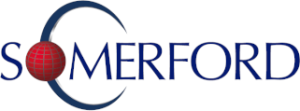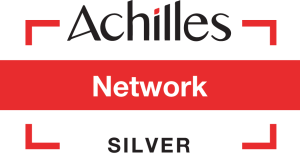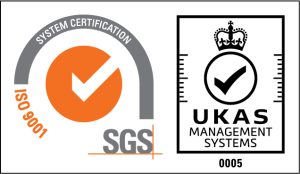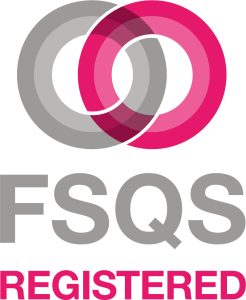Carbon Reduction Policy and Plan
1. Introduction
In 2019 the UK Government amended the Climate Change Act 2008 by introducing a target of at least a 100% reduction of greenhouse gas emissions (compared to 1990 levels) in the UK by 2050. This is otherwise known as the ‘Net Zero’ target.
Management and staff at Somerford have been conscious of our impact upon the environment even before the Climate Change Act was introduced, and we’ve adopted environmentally friendly practices as the business has grown. Consequently, Somerford ‘s business already has an internal driver to reduce our carbon emissions. We will continue to strive for further reductions, using this policy and baseline to measure the impact of our mitigation actions and to adjust our response acccordingly, as this is beneficial for our business, our stakeholders and the environment. Somerford works closely with the public sector and is keen to deliver our part of achieving the Net Zero target.
2. Carbon Reduction Commitment
- details our Greenhouse Gas emissions;
- baselines our Greenhouse Gas emissions;
- sets out the schedule of carbon reduction in order to achieve Net Zero by 2050;
- details the monitoring processes we will follow in order to track our progress along our plan;
- details the mitigation measures to reduce our carbon impact that are both in place and planned approach;
- has been approved and signed off by our management team.
3. Our Business and Carbon Impact
3.1 Scope 1 emissions
3.2 Scope 2 emissions
Somerford’s only significant scope 2 emissions are those associated with the energy supplied to our offices and the limited IT equipment located within the Office, which is acquired via a managed offices agreement which provides 100% of their energy from renewable sources.
Our production IT systems have been virtualized using Amazon Web Services (AWS) and Google Cloud Platform (GCP), who in turn use energy to support our estate in the cloud.
3.3 Scope 3 emissions
Scope 3 emissions are all the indirect emissions that occur because of normal business activity. For example: waste (decomposing waste emits greenhouse gases); emissions related to any goods or services purchased (for example any fuel emitted transporting them); employees commuting to and from work.
They are further classified as:
- Purchased goods and services
- Capital goods
- Fuel and energy related activities (not included in scope 1 or scope 2)
- Upstream transportation and distribution
- Waste generated in operations
- Business travel
- Employee commuting
- Upstream leased assets
- Downstream transportation and distribution
- Processing of sold products
- Use of sold products
- End of life treatment of sold products
- Downstream leased assets
- Franchises
- Investments
The remaining sources of emissions are in scope 3. These incorporate our business travel. Somerford has no company cars but there is car travel in the form of taxis and employee owned vehicles. There are some flights, tubes, trains and bus travel.
Somerford’s staff either work from home or are located at our customers’ sites. The choice of location is determined by the nature of the work undertaken by the employee and how this can be delivered most effectively for our business and for our customers. The transportation has been categorised as Business Travel as opposed to Employee Commute. This takes into account the carbon cost associated with the choice of the location in terms of the amount of energy and services required, time and fuel consumption due to travel, and job effectiveness, including quality of communications etc.
The vendors whose products we resell and provide our wrap around services for also have their own emissions. They also have scopes 1, 2 and 3 of emissions and we take responsibility for part of their emissions in proportion to the amount that we resell. We have categorised this as 1. Purchased goods and services.
The other subcategories of Scope 3 are zero.
4. Baseline
Baseline emissions are a record of the greenhouse gases that have been produced in the past, and against which future emissions reduction can be compared.
Somerford has analysed several years of carbon emissions and initially selected 2019 as the baseline. However, due to our largest supplier Splunk changing the methodology of their reporting and because the impact of the pandemic in 2019 – 20 put a potential false positive on preceding years we have decided to rebaseline in reporting year 2021. This then aligns with the Splunk who also baselined on the reporting period of 2021. This rebaselining removes the Splunk change in reporting methodology and the covid impacts to a more consistent report. In 2023 we have seen an increase in our scope 3 emissions which is totally attributed to our largest Partner Splunk including Scope 3 category 1. purchased Goods and Services in their calculations .
The calculations and assumptions for the baseline have been detailed in Somerford Associates Carbon Reduction Baseline and Plan Fig 1 details our baseline.

5. Plan and Schedule of Carbon Reduction
To show our commitment to achieving net carbon of zero by 2050, the baseline has been projected out and a reduction of 17% is required year on year to achieve net carbon rounding to zero in 2050. It is acknowledged that as Somerford Associates grows, more carbon would be produced, so a normalised figure based on projected growth is used to calculate the rate of reduction required. The ratio of metric tonne of carbon per £1m of revenue is used to normalise against this growth (see figure 3). Between some years, the actual carbon emissions may grow but as long as we are on track to reduce to net zero based on the normalised figure we are targeting to be able to account for this growth and reach net zero by the 2050 deadline.
We have seen an increase in our reported emissions for 2023. A key contributing factor to the Somerford published emissions for reporting year 2023 is the carbon reduction statistic published by our largest source of emissions, our partner Splunk who have now included Scope 3 category 1. purchased Goods and Services in their calculations which was not previously reported. Somerford emissions also increased though slightly due to an increase in air travel as Business meeting in person resumed such as partner Kickoff in United States of America.
The unnormalised quantity of emissions at 2050 we commit to offset to reach zero equivalence.
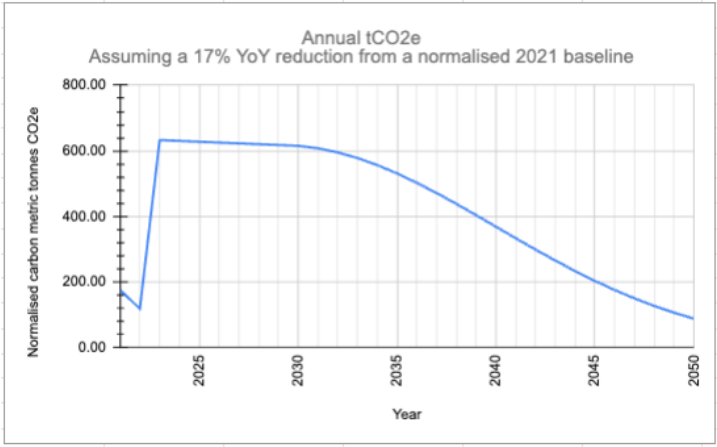
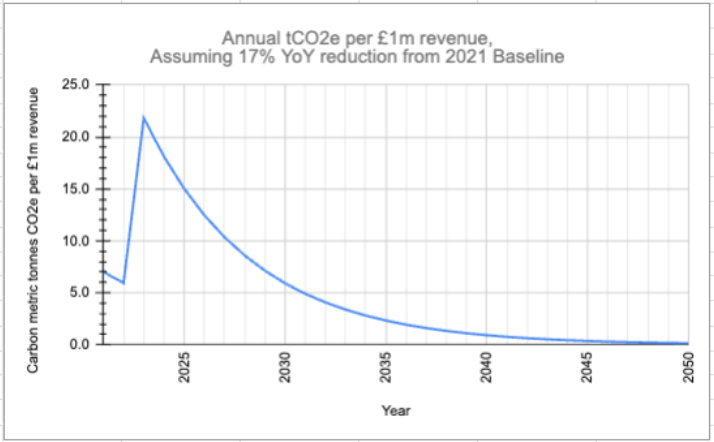
6. Monitoring Commitment
7. Mitigation Actions
In order to meet the targeted carbon reduction a concerted effort will need to be made. There are many mitigation actions in place now and planned as recorded in the Somerford Associates Carbon Reduction Baseline and Plan which will be used as a live plan whereby ideas for the reduction of carbon can be added and as actions are completed they can be put into “In Place Yr 20XX”. These actions are summarised in the following tables and further explained below. They are a current snapshot of our plans correct at the date of approval.
7.1 Current Measures In Place
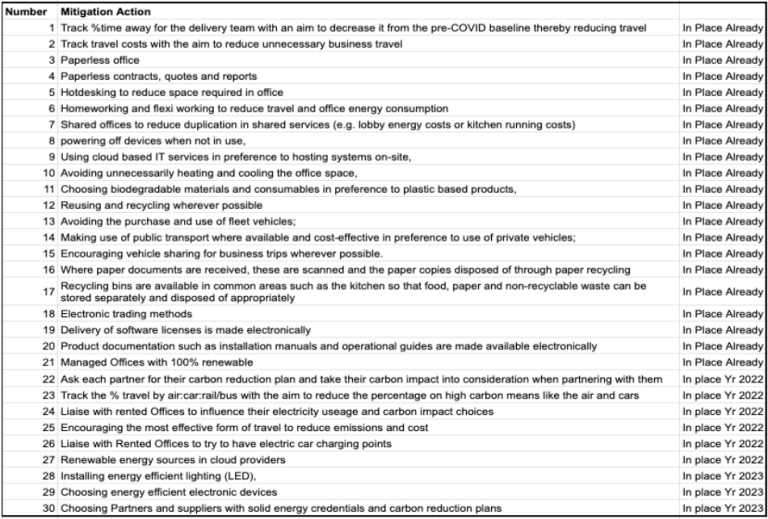
The products we sell are digital in nature, and are delivered to our customers securely over the Internet. We are a value added reseller (VAR) of the software products made by our supplier-partners; we do not develop software products of our own. We do not physically manufacture goods ourselves, or process, or supply materials in any significant way.
The software is typically distributed directly between our partner-supplier and our customer with no intervention on our part. Delivery is made electronically rather than using media such as tapes and discs. Similarly, product documentation such as installation manuals and operational guides are made available electronically and we avoid the distribution of paper documents and manuals to the greatest extent possible.
Our financial processes follow electronic trading methods to avoid unnecessary creation and storage of paper documents. This is also true for our internal administrative processes – we run a practically paperless office.
We have no company ‘fleet’ vehicles, although staff may use their own private vehicles for business travel when our travel policy allows and when justified.
Although Somerford is a growing and thriving business, we avoid unnecessarily extending our office space since this contributes to consumption of energy through heating, lighting and provision of office facilities and consumption of materials. Although some office desk space is necessary for effective operation of the business, this is provided as open-plan ‘hot-desking’ to make effective use of the space and promote good interaction between our staff.
Somerford’s office space is provided through a managed services organisation and the arrangement includes the provision of utilities including heating, lighting and electricity. We therefore have little opportunity to influence the selection of utility providers presently. However they also committed to a Carbon Net Zero plan which includes the utilities delivered to us which are from 100% sustainable sources.
With our move to a new office, Action 24 is complete and we now have access to electrical charging points which is a practical way to encourage electric car use.
Travel – Whenever practicable, Somerford uses contemporary communications technologies (for example, Google Meet) in preference to business travel when interacting with key stakeholders, including customers, partners, suppliers and other staff.
Through the monitoring of our carbon impact we have the opportunity to measure what travel choices employees are making (Action 23). Observing behaviour often produces a positive impact but the management agreeing to this policy also has the ability to encourage the most effective form of travel in both cost and emissions (Action 25).
Where travel is necessary, Somerford’ travel policy aims to reduce our carbon footprint by:
- Encouraging the most effective form of travel to reduce emissions and cost;
- Making use of public transport where available and cost-effective in preference to use of private vehicles;
- Avoiding the purchase and use of fleet vehicles;
- Encouraging vehicle sharing for business trips wherever possible.
Homeworking – Somerford adopts home working and flexible working arrangements in preference to unnecessary travel to/from our offices and allows greater national coverage by our professional services and technical teams. Emissions are also reduced due to avoidance of regular commuting as well as saving travel time for our staff.
Waste – Somerford has a near paperless operating practice in the office. Essential documents are exchanged electronically and stored digitally. Where paper documents are received, these are scanned and the paper copies disposed of through paper recycling. Recycling bins are available in common areas such as the kitchen so that food, paper and non-recyclable waste can be stored separately and disposed of appropriately. Office waste is therefore at a low level and primarily consists of food packaging from desk-side meals and snacks.
7.2 Future Mitigation Actions

Mitigation actions build on the mitigation actions that are already in place and through monitoring and engagement with our suppliers we would aim to reduce the carbon impact further.
Our largest source of carbon is our partner’s solutions. Action 33 is likely therefore to have the biggest positive impact for us. We plan to engage with each of our partners to ensure they have a feasible and proactive carbon reduction plan. Many have internal employee groups which steer their boards and a partner’s voice on the relevant environmental groups would help us bring influence. For the decision to partner with a vendor, we will have to keep our current partner choice based on the solution’s potential and quality for our clients. However, we can exert pressure on the supply base by actively tracking their carbon reduction plans during partner selection, and during our partnership thereafter.
We will be planning more proactive measures to encourage greener choices.
Such as a non financial rewards system within the Somerford staff in Actions 31 and 32 would aim to add more encouragement to make green choices.
We could incorporate Carbon Reduction Commitments into our partner choice policy (Action 33).
Action 34 refers to reducing our energy usage in the office and in the cloud.
Some actions are longer term initiatives that can reduce the impact further.
Actions 35, and 36, would require changes to the way we manage our IT estate. Some cloud providers offer infrastructure that they guarantee is powered by renewable sources. Whilst we are constrained by our partnerships with AWS and GCP and the operational advantages that gives us when we resell our products, we could begin to ask our cloud providers to offer this service and if it came up to use renewable sources. Currently our production instances are on AWS but on research GCP appears to be more advanced on their carbon strategy. The decision to move has yet to be decided upon and we continue to monitor the costs and assess our options
Containerised infrastructure in theory expands and contracts automatically based on usage. There might be use cases within our existing estate to use this to make sure we only use energy when required. We have already used a partner solution called Dat Advantage cloud which can identify stale data. Currently our data is in Google Workspaces which is using 100% renewable energy. If on assessment cold storage is assessed as better for the environment as it is requiring no energy usage, we might be able to archive more proactively into our back up systems. This will require analysis to compare cold storage (which needs production and purchasing) vs renewable energy.
8. Disclaimer and forward looking statement
The information and opinions contained in this report are provided as of the date of this report and are subject to change without notice. Somerford does not undertake to update or revise any such statements. This policy represents current Somerford policy and intent and is not intended to create legal rights or obligations. This report may contain or incorporate by reference public information not separately reviewed, approved, or endorsed by Somerford and no representation, warranty, or undertaking is made by Somerford as to the accuracy, reasonableness, or completeness of such information. Inclusion of information in this report is not an indication that the subject or information is material to Somerford’s business or operating results. This report includes forward-looking statements within the meaning of the Private Securities Litigation Reform Act of 1995. All statements other than statements of historical or current facts, including statements regarding our plans, initiatives, projections, goals, commitments, expectations, or prospects, are forward-looking. We use words such as aim, believe, commit, drive, estimate, ensure, expect, goal, intend, may, mission, plan, project, seek, strategy, strive, target, and will or similar expressions to identify forward-looking statements. Forward-looking statements reflect management’s current expectations and inherently involve risks and uncertainties. Actual results could differ materially due to a variety of factors, including assumptions not being realised, scientific or technological developments, evolving sustainability strategies, changes in carbon markets, evolving government regulations, our expansion into new products, services, technologies, and geographic regions, or other changes in circumstances, The standards of measurement and performance contained in the report are developing and based on assumptions, and no assurance can be given that any plan, initiative, projection, goal, commitment, expectation, or prospect set forth in this report can or will be achieved.
9. Approval
Andy Davies, Director
25/03/2024
